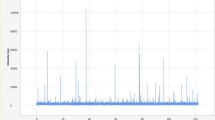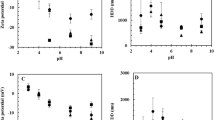Abstract
Silver nanoparticles (AgNPs) are used in a large number of consumer products due to their antimicrobial and antifungal properties, and these materials may be discharged into municipal wastewater. Wastewater treatment, including advanced oxidation processes (AOPs), may modify the forms of silver in wastewater before they are discharged into surface waters. In addition, little is known about the changes in AgNPs that occur in natural waters under different environmental conditions. In this project, we utilized single particle ICP-MS (spICP-MS) and dynamic light scattering (DLS) analytical techniques to evaluate changes in the number and size of AgNPs in laboratory experiments with milliQ water under different environmental conditions, as well as during ozonation. Changes in the number and size of AgNPs determined by spICP-MS were evidence of altered stability of the nanoparticles. Increased rates of dissolution occurred under extremes of pH. Lower temperature decreased the rate of dissolution of AgNP relative to the dissolution in treatments at room temperature. The addition of chloride resulted in the loss of AgNPs from suspension due to agglomeration and precipitation. Ozonation led to a rapid decline in the number and size of AgNPs, as indicated by both spICP-MS and DLS analysis. An increase in the concentration of dissolved silver in the ozone treatments was evidence that changes in particle size were a result of oxidative dissolution of AgNPs to silver ion.

Single particle ICP-MS is used to evaluate dissolution of silver nanoparticles under different environmental conditions, including water treatment by ozonation





Similar content being viewed by others
References
Nowack B, Ranville J, Diamond S, Gallego-Urrea J, Metcalfe CD, Rose J, et al. Potential scenarios for nanomaterial release and subsequent alteration in the environment. Environ Toxicol Chem. 2012;31:50–9.
Garner KL, Suh S, Lenihan HS, Keller AA. Species sensitivity distributions for engineered nanoparticles. Environ Sci Technol. 2015;49:5753–9.
Kim B, Park CS, Murayama M, Hochella MF. Discovery and characterization of silver sulfide nanoparticles in final sewage sludge products. Environ Sci Technol. 2010;44:7509–15.
Kaegi R, Voegelin A, Ort C, Sinnet B, Thalmann B, Krismer J, et al. Fate and transformation of silver nanoparticles in urban wastewater systems. Water Res. 2013;47:3866–77.
Ma R, Levard C, Judy JD, Unrine JM, Durenkamp M, Martin B, et al. Fate of zinc oxide and silver nanoparticles in a pilot wastewater treatment plant and in processed biosolids. Environ Sci Technol. 2013;48:104–12.
Yang Y, Chen Q, Wall JD, Hu Z. Potential nanosilver impact on anaerobic digestion at moderate silver concentrations. Water Res. 2012;46:1176–84.
Dumont E, Johnson AC, Keller VDJ, Williams RJ. Nano silver and nano zinc-oxide in surface waters—exposure estimation for Europe at high spatial and temporal resolution. Environ Poll. 2015;196:341–9.
Ho CM, Yau SKW, Lok CN, So MH, Che CM. Oxidative dissolution of silver nanoparticles by biologically relevant oxidants: a kinetic and mechanistic study. Chem Asian J. 2010;5:285–93.
Mitrano DM, Ranville JF, Bednar A, Kazor K, Hering AS, Higgins CP. Tracking dissolution of silver nanoparticles at environmentally relevant concentrations in laboratory, natural and processed water using single particle ICP-MS (spICP-MS). Environ Sci Nano. 2014;1:248–60.
Thalmann B, Voegelin A, von Gunten U, Behra R, Morgenroth E, Kaegi R. Effect of ozone treatment on nano-sized silver sulfide in wastewater effluent. Environ Sci Technol. 2015;49:10911–9.
Notter DA, Mitrano DM, Nowack B. Are nanosized or dissolved metals more toxic in the environment? A meta-analysis. Environ Toxicol Chem. 2014;33:2733–9.
Kittler S, Greulich C, Diendorf J, Koller M, Epple M. Toxicity of silver nanoparticles increases during storage because of slow dissolution under release of silver ions. Chem Mater. 2010;22:4548–54.
Elzey S, Grassian VH. Nanoparticle dissolution from the particle perspective: insights from particle sizing measurements. Langmuir. 2010;26:12505–8.
Peretyazhko TS, Zhang Q, Colvin VL. Size-controlled dissolution of silver nanoparticles at neutral and acidic pH conditions: kinetics and size changes. Environ Sci Technol. 2014;48:11954–61.
Li X, Lenhart JJ. Aggregation and dissolution of silver nanoparticles in natural surface water. Environ Sci Technol. 2012;46:5378–86.
Delay M, Dolt T, Woellhaf A, Sembritzki R, Frimmel FH. Interactions and stability of silver nanoparticles in the aqueous phase: Influence of natural organic matter (NOM) and ionic strength. J Chromatogr A. 2011;1218:4206–12.
Degueldre C, Favarger P, Wold S. Gold colloid analysis by inductively coupled plasma-mass spectrometry in a single particle mode. Anal Chim Acta. 2006;555:263–8.
Laborda F, Jimenez-Lamana J, Bolea E, Castillo JR. Selective identification, characterization and determination of dissolved silver (I) and silver nanoparticles based on single particle detection by inductively coupled plasma mass spectrometry. J Anal At Spectrom. 2011;26:1362–71.
Mitrano DM, Lesher EK, Bednar AJ, Monserud J, Higgins CP, Ranville JF. Detection of nano-Ag using single particle inductively coupled plasma mass spectrometry. Environ Toxicol Chem. 2012;31:115–21.
Furtado LM, Hoque ME, Mitrano DF, Ranville JF, Cheever B, Frost PC, et al. The persistence and transformation of silver nanoparticles in littoral lake mesocosms monitored using various analytical techniques. Environ Chem. 2014;11:419–30.
Larcher S, Delbѐs G, Robaire B, Yargeau V. Degradation of 17α-ethinylestradiol by ozonation—identification of the by-products and assessment of the estrogenicity and toxicity. Environ Int. 2012;39:66–72.
Hadioui M, Leclerc S, Wilkinson K. Multimethod quantification of Ag + release from nanosilver. Talanta. 2013;105:15–9.
Pace HE, Rogers NJ, Jarolimek C, Coleman VA, Higgins CP, Ranville JF. Determining transport efficiency for the purpose of counting and sizing nanoparticles via single particle inductively coupled plasma mass spectrometry. Anal Chem. 2011;83:9361–9.
Telgmann L, Metcalfe CD, Hintelmann H. Rapid size characterization of silver nanoparticles by single particle ICP-MS and isotope dilution. J Anal Atom Spectrom. 2014;29:1265–72.
Laborda F, Jimenez-Lamana J, Bolea E, Castill JR. Critical considerations for the determination of nanoparticle number, concentrations, size and number size distributions by single particle ICP-MS. J Anal At Spectrom. 2013;28:1220–32.
Cornelis G, Hassellӧv M. A signal deconvolution method to discriminate smaller nanoparticles in single particle ICP-MS. J Anal At Spectrom. 2014;29:134–44.
Montaño MD, Badiel HR, Bazargan S, Ranville JF. Improvement in the detection and characterization of engineered nanoparticles using spICP-MS with microsecond dwell times. Environ Sci Nano. 2014;1:338–46.
Liu J, Hurt R. Ion release kinetics and particle persistence in aqueous nano-silver colloids. Environ Sci Technol. 2010;44:2169–75.
Domingos RF, Baalousha MA, Ju-Nam Y, Reid MM, Tufenkji N, Lead JR, et al. Characterizing manufactured nanoparticles in the environment: multimethod determination of particle sizes. Environ Sci Technol. 2009;43:7277–84.
Gallego-Urrea JA, Tuoriniemi J, Pallander T, Hassellöv M. Measurements of nanoparticle number concentrations and size distributions in contrasting aquatic environments using nanoparticle tracking analysis. Environ Chem. 2010;7:67–81.
Acknowledgments
This work was supported by a grant to V. Yargeau (PI) and colleagues from the Natural Sciences and Engineering Research Council (NSERC) of Canada through the Strategic Grants program. Support for a Postdoctoral Fellowship for L. Telgmann was provided by a fellowship of the German Research Foundation (Deutsche Forschungsgemeinschaft).
Author information
Authors and Affiliations
Corresponding author
Ethics declarations
Conflict of interest
All co-authors declare that they do not have a conflict of interest affecting the presentation and interpretation of data in this manuscript.
Additional information
Published in the topical collection Single-particle-ICP-MS Advances with guest editors Antonio R. Montoro Bustos and Michael R. Winchester.
Rights and permissions
About this article
Cite this article
Telgmann, L., Nguyen, M.T.K., Shen, L. et al. Single particle ICP-MS as a tool for determining the stability of silver nanoparticles in aquatic matrixes under various environmental conditions, including treatment by ozonation. Anal Bioanal Chem 408, 5169–5177 (2016). https://doi.org/10.1007/s00216-016-9685-7
Received:
Revised:
Accepted:
Published:
Issue Date:
DOI: https://doi.org/10.1007/s00216-016-9685-7




